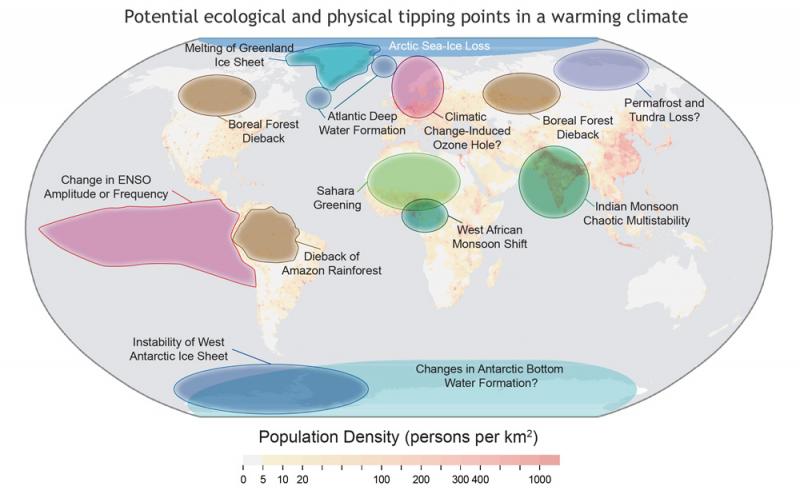
Ecosystems
- Despite extensive human engineering of Earth’s resources, our economy and culture continue to depend on natural ecosystem services for food, timber, clean water, and more.
- Species and ecosystems are already contending with multiple environmental stresses, including pollution and overharvesting, and climate change amplifies those threats.
- The pace of change and future climate conditions will likely exceed the historical range of variability under which current ecosystems evolved and function, and some of the impacts on fire regimes, water resources, carbon storage, invasive species, and biodiversity may be unpredictable.
- The most robust approach to helping fish, wildlife, and plants adapt to climate change is to conserve enough variety and amount of habitat to sustain diverse and healthy populations.
Key points:
The value of ecosystems
From large-scale agriculture, to massive dams and reservoirs, to managed fire regimes dating back thousands of years, humans have transformed the planet by engineering Earth’s physical and biological systems to better serve our needs and desires. Even with these transformations, however, humans continue to depend on the life-sustaining benefits and services provided by natural environments.
These benefits and services are known as “ecosystem services,” and they underpin our economy by providing food, jobs, building materials, medicines, clean water, outdoor recreation, and wildlife habitat, while also protecting our communities from extreme events such as flooding, storm-surge, drought, heat waves, and wildfire.
Economists and natural resource managers have tried to put a price tag on some of these services—timber, seafood, tourism, water purification—while the economic value of others—biodiversity, cultural or tribal identity, quality of life—remains conceptual. By one estimate, the total global value of ecosystem services has been valued at between $125–145 trillion per year (based on 2007 US dollars).1
As the climate changes, it will influence the distribution, extent, and composition of ecosystems, and hence affect the spectrum of services and economic value they provide. Society’s choices of what actions to take in the face of climate change can either make it harder or easier for ecosystems to continue to provide the necessary goods and services we require. Effective action by resource managers, communities, and the public is both possible and essential.
This introduction is abridged from the report National Fish, Wildlife, and Plants Climate Adaptation Strategy, Section 1.3.3 and 1.3.4.
Climate change impacts on ecosystems
While the climate has always exhibited variability and major climatic shifts have occurred throughout geological history, warming this century is likely to occur 10 times faster than during any climatic shift in the past 65 million years.
This warming will impact ecosystems through heat stress, precipitation changes and alterations in biogeochemical cycles and energy flows. Unfortunately, species and ecosystems are already contending with multiple other environmental stresses, such as habitat loss, pollution, invasive species, and over-harvesting. The cumulative effect of these multiple stressors, in concert with a rapidly changing climate, is expected to disrupt ecosystem processes and services, and increase the risk of species extinctions.
Recent studies have shown that species throughout North America have moved to higher elevations at a median rate of 36 feet per decade, and to higher latitudes at a median rate of 10.5 miles per decade, two to three times faster than previously reported in the scientific literature. Currently forecasted rates of climate change will likely necessitate migration rates that exceed the ability of many species, and thus threaten them with extinction.
Species respond to climate change in different ways and at different rates. This diversity in responses increases the likelihood that important interconnections that have evolved over millennia—such as between pollinators and the flowers they fertilize, or breeding birds and the insects on which they feed—will be disrupted and fail. In addition, the confounding effects of other stressors such as land use change and pollution may hinder or prevent innate adaptive responses.
As climate conditions exceed the historical range of variability under which our current ecosystems function, it is likely that key ecological thresholds or tipping points will be surpassed. Recent studies indicate that ecosystems as diverse as western North American forests and Caribbean coral reefs are increasingly vulnerable to transformative ecological change.
The preceding text is excerpted and abridged from Climate-Smart Conservation: Putting Adaptation Principles into Practice, Chapter 1, Section 1.
Georgakakos, A., P. Fleming, M. Dettinger, C. Peters-Lidard, Terese (T.C.) Richmond, K. Reckhow, K. White, and D. Yates, 2014: Ch. 3: Water Resources. Climate Change Impacts in the United States: The Third National Climate Assessment, J.M. Melillo, Terese (T.C.) Richmond, and G. W. Yohe, Eds., U.S. Global Change Research Program, 69–112. doi:10.7930/J0G44N6T.
To learn more about the impacts of climate change and variability on ecosystem vulnerability, visit the subtopic pages:
- Fire Regimes
- Water Resources
- Carbon Balance
- Invasive Species
- Biodiversity Conservation
- Protecting and Enhancing the Resilience of Ecosystems
- 1. Costanza, R., R. de Groot, P. Sutton, S. van der Ploeg, S. Anderson, I. Kubiszewski, S. Farber, and R.K. Turner, 2014: Changes in the global value of ecosystem services. Global Environmental Change, 26, 152–158.



